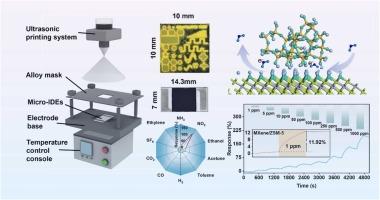ZSM-5分子筛MXene界面工程:超灵敏NO2检测的原子级电荷转移途径
IF 3.7
1区 化学
Q1 CHEMISTRY, ANALYTICAL
引用次数: 0
摘要
二氧化氮(NO2)是一种剧毒空气污染物,危害人类健康、环境可持续性和生态系统。为了解决这一问题,我们通过简便的合成路线将ZSM-5分子筛与MXene结合,设计了一种无机非均相界面。这种独特的结构将ZSM-5的双跨通道框架与MXene的高导电性和丰富的表面官能团协同作用。这种组合极大地提高了电子传递动力学,界面NO2吸附和气体传感性能。优化后的MXene/ZSM-5纳米复合材料的NO2检测限为1 ppm。其响应率比原MXene高79.78%。该纳米复合材料还具有优异的稳定性和显著的抗干扰性能。相关性研究证实了湿度和大气条件下的一致性能。密度泛函理论(DFT)计算在原子水平上阐明了提高灵敏度的电荷转移途径和吸附机制。通过开创MXene/ZSM-5界面,并系统地研究其气体相互作用动力学,这项工作为设计下一代基于MXene的气体传感器提供了基础见解。本文章由计算机程序翻译,如有差异,请以英文原文为准。

Interface Engineering of MXene using ZSM-5 Molecular Sieve: Atomic-Level Charge Transfer Pathways for Ultra-Sensitive NO2 Detection
Nitrogen dioxide (NO2) is a highly toxic air pollutant that endangers human health, environmental sustainability, and ecosystems. To address this issue, we designed an inorganic heterogeneous interface by integrating ZSM-5 molecular sieves with MXene via a facile synthesis route. This unique architecture synergizes the dual cross-channel framework of ZSM-5 and the high electrical conductivity and abundant surface functional groups of MXene. This combination greatly enhances electron transfer kinetics, interfacial NO2 adsorption, and gas sensing properties. The optimized MXene/ZSM-5 nanocomposite achieves an ultra-low NO2 detection limit of 1 ppm. Its response is 79.78% higher than that of original MXene. The nanocomposite also exhibits excellent stability and significant anti-interference properties. Correlation studies confirm consistent performance across humidity and atmospheric conditions. Density functional theory (DFT) calculations elucidated the charge transfer pathways and adsorption mechanisms at the atomic level that enhance sensitivity. By pioneering the MXene/ZSM-5 interface and systematically investigating its gas interaction kinetics, this work provides fundamental insights for designing next-generation MXene-based gas sensors.
求助全文
通过发布文献求助,成功后即可免费获取论文全文。
去求助
来源期刊

Sensors and Actuators B: Chemical
工程技术-电化学
CiteScore
14.60
自引率
11.90%
发文量
1776
审稿时长
3.2 months
期刊介绍:
Sensors & Actuators, B: Chemical is an international journal focused on the research and development of chemical transducers. It covers chemical sensors and biosensors, chemical actuators, and analytical microsystems. The journal is interdisciplinary, aiming to publish original works showcasing substantial advancements beyond the current state of the art in these fields, with practical applicability to solving meaningful analytical problems. Review articles are accepted by invitation from an Editor of the journal.
 求助内容:
求助内容: 应助结果提醒方式:
应助结果提醒方式:


